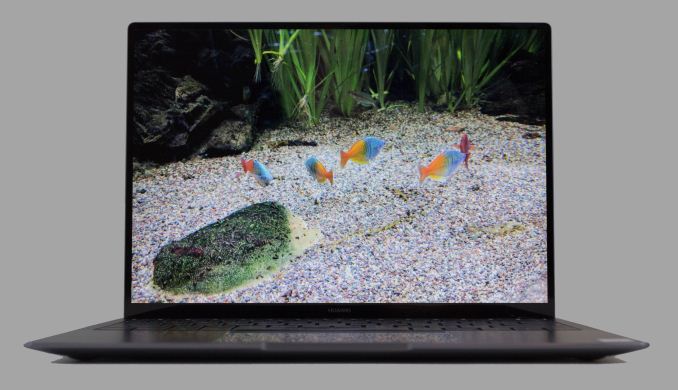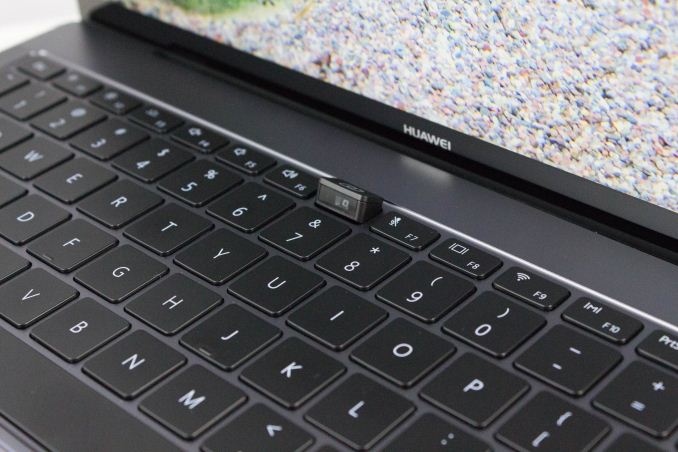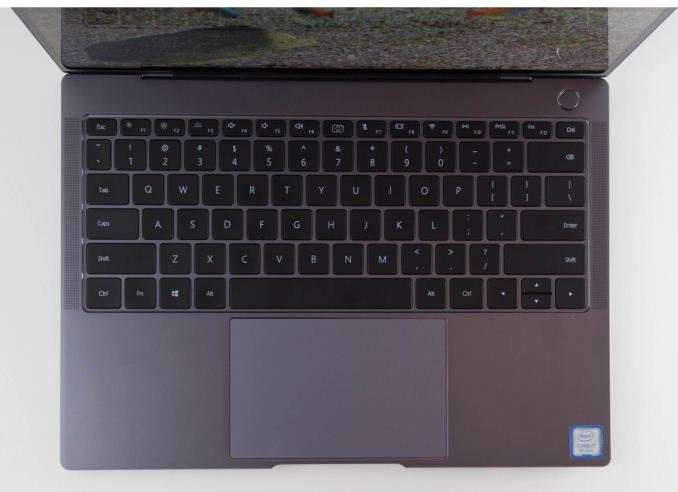The Huawei MateBook X Pro Review: Calling Out The Competition
by Brett Howse on June 27, 2018 8:00 AM ESTDesign
Huawei doesn’t seem to shy away from where they get their design inspirations, with the company proudly comparing it side by side with the latest MacBook Pro lineup. But they’ve still done some interesting takes on the Ultrabook design and have crafted a beautiful looking laptop with the MateBook X Pro.
Obviously one of the focal points is the display, which is surrounded by bezels just 4.4 mm on each side. This makes for a pretty stunning look, and Huawei took a design cue from Dell here by shrinking the top bezel as well. There’s no doubt that it makes the laptop look more balanced, but in order to do this the webcam had to be relocated from the top of the display. Dell tucks it under the display, but with Huawei using a taller 3:2 aspect panel, they’ve instead moved the webcam under a pop-up key cap between F6 and F7. Clearly this is going to have the same up-the-nose look of using an XPS 13 webcam, but if you do want to adjust the angle of the webcam you’d have to tilt the entire laptop base, which isn’t ideal. If you use a webcam all the time on your laptop, this one issue is likely a deal breaker, but on the other hand, by being able to tuck the webcam away, there’s definitely a privacy enhancement with this take. It’s a bit odd, but it all comes down to how much you rely on a webcam on your laptop on whether this is going to be an issue or not.
The rest of the design is a lot less compromising. The all-aluminum chassis is great to handle, and comes in two colors depending on the model. The Mystic Silver is offered on the Core i5 model, and the Core i7 version is outfitted in a Space Gray color. The laptop is also very thin, at just 14.6 mm, or 0.57-inches, and the laptop comes in under 3 lbs at 1.33 kg / 2.93 lbs. The laptop feels a lot smaller than you’d expect for a 13.9-inch laptop thanks to the small bezels and squarer aspect ratio. It’s hard to believe laptops used to come with such enormous bezels when you get to see these latest breeds in person.
The review unit has a bit of a creak on the bottom left side when picking it up, but speaking to others that have used or are using this notebook, that doesn’t seem to be a widespread issue luckily.
Opening the laptop, we can take a look at the keyboard and trackpad. Huawei has gone with a very standard keyboard layout, which is very welcome. There’s the usual compactness of certain keys like the arrow keys, but that’s to be expected when the entire design is in such a small space. It’s a full six-row keyboard though, and other than the webcam being on the top row, it’s all well thought out.
Using the keyboard is above average, despite there only being 1.1 mm of key travel on this notebook. There’s a good amount of resistance when pressing the keys, so they feel better than you’d think for such a short throw. Despite Huawei definitely taking inspiration from Apple on the design, they’ve kept the traditional key feel here. Some extra travel would likely improve the keyboard a bit, and some contour to the key caps might help as well, but the balance is still quite good.
The keys are of course backlit too, but there’s just two levels of backlighting, and even at the brightest, it could stand to be just a bit brighter. In addition, Huawei doesn’t light up the backlighting when you use the trackpad, so when using the laptop in a dim room, it can be a bit more challenging to get lined up with the keys when you want to type. Most laptops do turn on the backlighting when you move the cursor, and this one should as well. It’s a small issue, but one worth pointing out.
The trackpad is a master stroke though. It’s oversized, but without being in your way like some of the other large trackpads, and it works very well. The trackpad material is incredibly smooth, and very responsive. The Surface Book likely has the best trackpad on a PC, and Huawei has arguably matched it.
On the keyboard deck is also two of the four speakers that Huawei has fitted in, with the second pair on the bottom near the front, and, incorporated into the power button is a fingerprint sensor for Windows Hello login.
Huawei has done an amazing job with the design. The thin bezels, coupled with the taller display, make for an incredibly compact 14-inch laptop, and despite the larger display size, it’s still very thin, and very light. There’s enough connectivity to get you by while still being plugged in, which isn’t something that can be said about all thin and light notebooks. As long as you don’t mind the webcam placement, there’s little to be upset about by the design of this MateBook X Pro.















77 Comments
View All Comments
MrSpadge - Wednesday, June 27, 2018 - link
I really like the meaningful and fairly priced separation between the i5 and i7 model - keep it simple and the upgrade noticeable to the user.SirCanealot - Wednesday, June 27, 2018 - link
Actually, I was thinking the same thing! For the sake of $300 I can upgrade almost everything on the system. For $300 to do that, it's quite a 'may as well' situation! :)DiscoDJ - Wednesday, June 27, 2018 - link
I know the internet is international in scope, but I do find it interesting that this article doesn't even mention the security issues the U.S. Govt. (whatever you may think of it, right now) has with Huawei or ZTE. Is there an article on this site somewhere that dismisses these concerns as unfounded?RedKiwi - Wednesday, June 27, 2018 - link
Reading through the summary of the House intelligence report on Huawei and ZTE, it seems more of a "not worth the risk" type of situation. Investigating hardware provided by Huawei and ZTE was out of the scope of the investigation. The House only questioned their involvement with the Chinese government. Both companies were unable to provide a satisfactory answer to the committee. By not allowing Huawei and ZTE to sell telecommunications equipment to US carriers, it removes the possibility of snooping even if there is no risk in the first place.I do believe consumer hardware Huawei makes is safe for general use. It might not be worth it for the government to risk.
On a side note, I wish some of these decisions would be made in other parts of the US government such as environmental laws.
vanilla_gorilla - Wednesday, June 27, 2018 - link
That's one of the most reasonable replies to that question I've seen.But we can't ignore the fact that in 2017 ZTE plead guilty to illegaly exporting US technology to Iran and North Korea.
Let me say that again: Iran and North Korea. In violation of international trade sanctions.
Then when the US called them on it, they agreed to reprimand employees and pay a fine. Instead, they only fired 4 officials and provided bonuses to 35 others. That's why the US Department of Commercen banned companies from buy ZTE products.
I don't think there's much more anaysis the government needs to do. Security is all based on trust and ZTE has zero. I wouldn't trust them as far as I could throw them.
ianmills - Wednesday, June 27, 2018 - link
Well the results sound about par for how the US handled their own 2009 financial crisis hahainvinciblegod - Wednesday, June 27, 2018 - link
"But we can't ignore the fact that in 2017 ZTE plead guilty to illegaly exporting US technology to Iran and North Korea. Let me say that again: Iran and North Korea. In violation of international trade sanctions."You say that like it's a super surprising thing but you'll be surprised to learn that many companies actually make a cost benefit analysis and more often than would be expected choose to illegally export US parts to those countries. They just know that if they get caught they will pay a fine and then everything is fine. Just search "companies that violate sanctions to iran" on google and you will see how many companies do it and get caught. ZTE obviously miscalculated on how much they could get away with in the plea deal.
invinciblegod - Wednesday, June 27, 2018 - link
Also, ZTE is not Huawei.Samus - Thursday, June 28, 2018 - link
LOL I was about to say the same thing.Oxford Guy - Tuesday, July 3, 2018 - link
Yep. If the benefit (the profit) outweighs the slap on the wrist (the cost) then why wouldn't any corporation go for it? Corporations are not people. They're financial mechanisms designed to enrich some people. They just happen to have real people to do some of that work (along with AI, robotics, etc.).